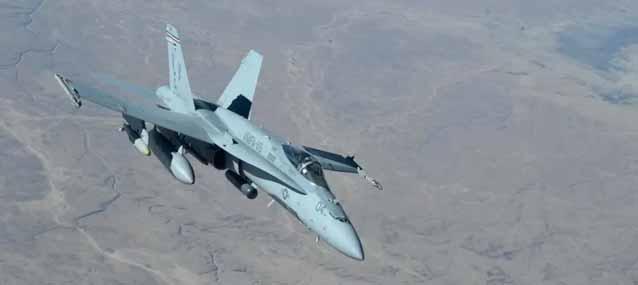
8 minute read
POLITICS
from Issue #1300
Wings Over Georgia: Retired Warplanes Can Find New Life in the Georgian Air Force
The Su-25 has its technology geared towards engaging enemy ground forces. The lack of an air-to-air component is a dangerous gambit, despite Georgia’s excellent surface-to-air capabilities and history. Image source: Georgian Defense Journal via Twitter
Advertisement
ANALYSIS BY MICHAEL GODWIN
The recent Independence Day celebrations on May 26 were a beautiful moment of national pride. It was also a showcase of some of the nation’s defense and security forces, complete with a fl yover of the nation’s newly updated Su-25UB Close-Air-Support (CAS) attack aircraft, codenamed in NATO circles as the “Frogfoot.” This is a great achievement in terms of national defense advancement and expansion. However, the country’s natural predator, Russia, isn't going to be deterred by three updated airframes.
Georgia’s friends, particularly the United States, are in the business of producing, upgrading, and most importantly selling some of the world's best aircraft technology. With the United States and other NATO states moving their military aircraft platforms to newer 5th or even 6th generation aircraft, such as the F-35A Joint Strike Fighter, this puts Georgia in a proverbial fork in the road: join the acquisition of F-35s, or buy up all the discounted F-16, F-18, and other European military aircraft.
However, the Georgian Ministry of Defense has already come to an agreement with Tbilisi Aircraft Manufacture (TAM) to continue upgrading the remaining Su-25UB and Su-25KM planes. This platform was fi rst produced in the late 1970s, being introduced formally in 1981 to the Soviet Air Force, and is now a largely outdated airframe, particularly in the framework of Black Sea/South Caucasus defense.
As Georgia was one of the manufacturers for these aircraft, after the fall of the Soviet Union it was stuck with both the plant and the planes. The two variants now in service are the Su-25UB, a twoseat training model, and the Su-25KM, a signifi cantly upgraded model. This upgraded model is the primary attack model, engineered in the early 2000s in tandem between TAM and an Israeli company, Elbit Systems. With advanced aerodynamics, targeting and weapons control, and new GPS navigation systems, these 6 models (still yet to be fl ightready) would be the best chance in a renewed air war in the region.
However, the Su-25 is a CAS aircraft and as such has virtually all of its technology geared towards engaging enemy ground forces. The lack of an air-to-air component is a dangerous gambit, despite Georgia’s excellent surface-to-air capabilities and history. The need for nearpeer air combat capability is still relevant and should also be included in the patrolling force NATO conducts over their skies.
At fi rst glance, the F-35 platform offers all the benefi ts and incentives there could be for a growing Air Force. However, Georgia may not be the best candidate for its implementation. It’s expensive, so much so that the Georgian treasury may buckle under that sort of fi nancial weight. Even with its implementation, this must be observed under “worst case scenario” conditions. If these highly effective aircraft are so deep within the Russian airstrike range, they would be the fi rst targets in a renewed confl ict. For the duration of the confl ict they would simply be burnt hulks on a tarmac. Hardly worth the exceptional price tag.
The veteran F/A-18 platform offers a multi-role fi ghter that could serve perfectly in a reinvigorated Georgian Air Force. With its similarly upgraded systems it stands to, albeit only somewhat, level the air playing fi eld. Russian attack aircraft would face greater deterrence, in addition to the deadly Georgian antiair artillery. In addition to countering any air aggression, this would allow Georgia to effectively join NATO’s air patrols in deterring Russian incursions in the Black Sea region.
With the United States and much of Europe’s militaries slowly phasing out these air platforms, Georgia could ostensibly obtain these at below market value. Next, the issues of supply and maintenance come into the picture. In addition to the purchase of the airframes, the purchase would have to include parts, software, and training from the seller. This could prevent the effective use of this new aircraft from being fully combat ready for months or even years. In addition to this, the recruitment needs for new air squadrons would be included.
Despite this, it’s not without note that a rebranding and recruitment surge would not hurt the nation. Remodeling their approach to young and eager patriots is something that could be a happy byproduct of adding new aircraft to the fl eet. Additional engineers, maintenance crews, administrative staff, trainers, and pilots would provide a great opportunity for Georgians to renew their view of Georgia’s largely overlooked Air Force.
However, it could also be that Georgia does not cease its own production. The continued production of Su-25s would expand the offensive and defensive capabilities against ground targets, as well as be available for export. A collaboration between the MoD and TAM is planning to produce the aircraft as their own model, renamed as the Ge-31 Bora.
A combined Air Force of ground attack, air-to-air, and air reconnaissance aircraft would put Georgia in command of the skies over the Eastern Black Sea and much of the Southern Caucasus. While it can be easily said that the costs in time, money, and human resources is too heavy, this investment of all involved resources only strengthens Georgia’s long-term position of dominance. This dominance is something overdue, and should never be out of the focus of the Ministry of Defense. Georgia is still a force for good in the region, along with its strategic partners and NATO as a whole.

If these highly effective aircraft are so deep within the Russian airstrike range, they would be the fi rst targets in a renewed confl ict, and hardly worth the exceptional price tag. Image source: Staff Sgt. Keith James/US Air Force
The Near East Getting Even Nearer
OP-ED BY NUGZAR B. RUHADZE
Talks about the differences and similarities between the Caucasus and the Near East (call it ‘Middle East’ if it feels better), have become more commonplace than ever before, and there must be a reason for this. But why should we be concerned about this unlikely comparison, and how much does it help us in terms of getting better versed in international politics? Well, if the Caucasus can manage to attract the world’s attention as the Middle East does, both being the cradles of ancient civilization, thus becoming another Mecca of tourism, then the comparison is going to be charged with positive energy. But if the Caucasus is compared to the Middle East more for its explosiveness and instability, then we have to think harder how to get rid of that kind of detrimental prospect, meaning that the peoples of the Caucasus will have to watch out to keep the place safe, peaceful, productive and attractive.
How to do this? In the fi rst place, by talking to each other in a more friendly and cooperative manner (meaning the South Caucasus nations of Armenia, globe, including the Caucasus, which is also vulnerable in almost the same way. Issues like displaced people, forced to move within their own country as well as beyond its borders as a result of confl ict or environmental disaster, constitute one of the most comparable features between the two regions, along with the fear of terrorism and the misgivings connected with political instability. On top of that, their visible similarity is based on their age-old cultural relationship rooted deep in history, their intermittent economic bonds, and likeness of temperament, which makes the mutual infl uence quite realistic, and thus prompting the West to hold the parallels between them reckonable.
While considering these similarities, certain amounts of weirdness pop up too: the three South-Caucasian countries drastically differ from each other when it comes to their attitudes towards the Middle East, with feelings alternating and concepts diverging, and if these features are characteristic, then their concerted cooperation with Middle-East countries might be considerably hampered. For instance, the Azeri closeness to Turkey might contradict the Armenian aversion to the same; the Georgian proximity to American interests in the region will probably clash with the RussianArmenian love affair; and the current Armenian fl uctuation between the North and the West could create certain fi dgety sentiments in all the rest.
This affordably brief evaluation of the situation would probably render the comparison between the two regions even more valid, but the further interaction between them is just as diffi cult. Let us say that it is merely a shared luck that wars, confl icts, terrorism and instability are present in both places, certainly not on the same scale, although both might remain continually pregnant with these scary infl ictions. Take Georgia, for example, which would love to carry on forever with close ties and fruitful coexistence with Israel, which might irritate other denizens of the Middle East. Hopefully, this would not procreate any danger for our peace-loving and good-lifehungry little country. The same would be true about the Azeri-Armenian-Turkish doubts and vacillations, and the Israeli-Palestinian not-very-peaceful interactions.
In conclusion, the Middle-Eastern and the Caucasian political, cultural and economic intertwining is nothing stable or very felicitous, but it is also credible that they do look both similar and different, needing each other in the happiest understanding of the word.

The Middle-Eastern and the Caucasian political, cultural and economic intertwining is nothing stable or very felicitous, but it is also credible that they do look both similar and different. Image source: expatexplore.com





